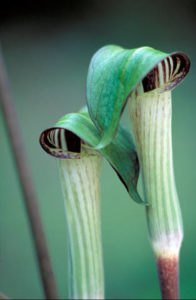As the Education Coordinator, I often ask younger children to use their “tools” when we are exploring the trails in the preserve. As adults, we take these tools for granted, but our eyes, ears, nose and hands can help us notice what is around us. It is easy to walk through the forest and only watch our footing, so we do not trip on a root. However, if we slow down, we can take the time to use our senses and enjoy nature’s wonders.
A recent walk on Trillium Trail revealed many interesting flowers. Nodding Trillium is currently in bloom, but you have to look closely to see the flower. The white flower hangs below the large leaves, giving it the appearance that it is nodding.
Another plant with a hidden, nodding flower is the Mayapple. If you are using your “tools,” you’ll notice patches of the large, umbrella-like leaves of this perennial. The plant has a single white flower that grows under the leaves. As their name suggests, Mayapples bear fruit. The fruit is bright yellow when ripe and is eaten by raccoons, opossums, skunks and other mammals.
Jack-in-the-pulpit can also be spotted along the trail. The flowers of this plant are not showy, but more archaic-looking. The “jack” is the flower structure, known as the spadix, located inside the “pulpit,” a modified, curved leaf called a spathe. The spathe is green with purple and greenish white stripes and is rolled into a deep cup with an overhanging roof. This may give the appearance of a preacher giving a sermon in the pulpit. The overhanging roof prevents rain from collecting inside, which would wash away the pollen. The flower emits a slight fungal smell, which attracts gnats and other insects for pollination.
Along Trillium Trail, you may notice the damp, earthy smell of the spring forest. Perhaps you will catch a whiff of the slightly sweet fragrance from the flowers of the Black Cherry trees.
In the late spring, you’re ears will treated to a full symphony in the forest. You may hear the emphatic, “Teacher! Teacher!” call of the Ovenbird, the long, cascading song of the Winter Wren or the slurred, questioning call of the Red-eyed Vireo. Birds aren’t the only animals making their presence known. The Gray Treefrogs loudly trill and the Green Frogs occasionally chime in with a “dunk, dunk.”
Late spring is an exciting time to be immersed in the forest. Even on the coolest and dampest of days, a short stroll can offer many delights – if you just take the time to notice. Next time you are in the forest, use your “tools” and you many be surprised at what you find.

